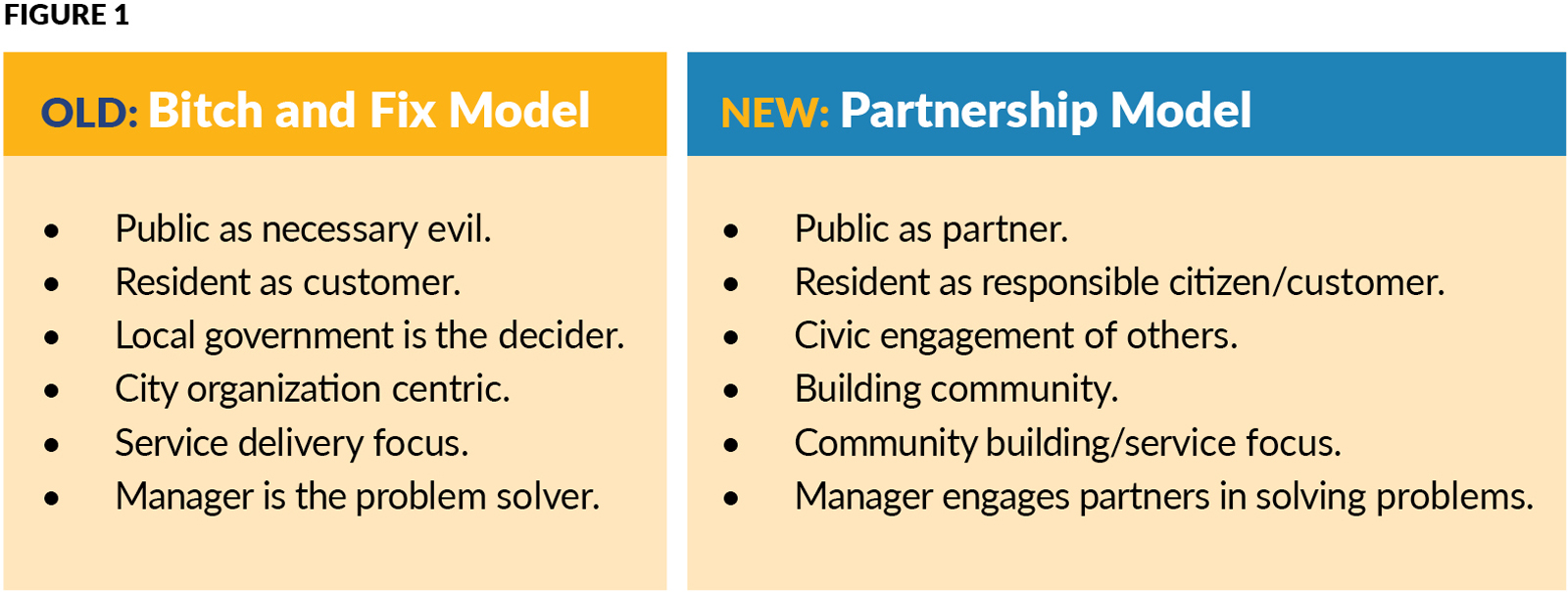
This article explores why local government does not embrace change even when research data tells us that what we are doing doesn’t work. This is the culmination of the previous articles in the “Let’s Think Differently About…” PM series. This entire series uses research and data to demonstrate to local government that we should significantly change or even eliminate some of our sacred practices, policies, and programs.
Thesis
Our resistance or avoidance to change is caused by four factors:
- How our brains work.
- Our monopoly status.
- Our culture and government model.
- Our lack of leadership.
I explain below how each of these conditions is holding us back.
Our Brains
Our brains form patterns, repetition, and habits. Our brains are wired to recognize patterns. Patterns initially help our brains make preliminary decisions through associations with what we have previously known. Human brains can’t help but look for patterns and find repetitive structures or procedures to deal with problems. Our brains are merely trying to be efficient. It is a bit of an over-simplification of the science, but our brains find patterns that lead us into repetitive thinking, which ultimately leads to habits and status quo thinking. Patterns, repetition, and habits served as survival mechanisms for our ancestors. Astrophysicist Neil deGrasse Tyson stated the following:
A hunter’s skills and patterns at spotting prey and predators and telling poisonous plants from healthy ones offered them a better chance of survival than those blind to these patterns. This enabled the survivors to pass on those pattern-friendly genes to future generations.
Some key findings about our brain are summarized here.1
- Our brain is 2% of our body weight, but uses 20% of the body energy. Thinking uses a lot of energy so optimizing our thinking is important.
- We process 126 bits of information per second, but our brain receives over 10 million bits of information per second. This means that we can only focus on 1/80,000th of the data our brain receives.
- Conscience thinking is a scare resource, so we build brain patterns to:
- Cause our brain to be more energy efficient.
- Free up the scare resource of conscious thinking.
- Permit our brains to do what they do best.
Since our brains love patterns, repetitions, and habits, our brains encourage us to do the same thing over and over. It is the reason many people never challenge the status quo and it prevents us from thinking differently. Patterns and repetition reinforce past practices and reduce innovative thinking. If that is how all brains work, then why is the private sector more creative and innovative than the public sector?
Our Monopoly
Investopedia provides a good definition of a monopoly:
A single organization supplying a good or service, a lack of competition in the specific market, so a similar substitute for the product or service is not available. Monopolies can dictate the price and create barriers for others to enter the marketplace.
Local government is not only a monopoly, but also a monopoly that can’t fail. No city or county is going out of business. A local government can go broke, but it is usually taken over by a county, state, or court master (another monopoly). There are no competitors for most of the services we offer, such as police services, fire protection, street repairs, sewers, water, or others. Most of us agree that we are a monopoly. The question is what is the impact of our monopolistic status?
Do monopolies prevent creativity and innovation? Economic theory on this question is mixed.
1. One economic theory states that monopolies restrict innovation, which is supported by an abundance of historical data from economists. Economists argue that monopolies want to control the market, and they don’t want to introduce new products or services that others might replicate or copy. Status quo keeps their monopoly intact.
2. Another economic theory states that some monopolies restrict innovation; however, these economists argue that large and profitable monopolies enhance innovations. Their argument is that profitable monopolies use their enormous wealth to fund research and development that smaller companies can’t do.
Before the federal government broke up the AT&T monopoly, it funded the infamous Bell Labs, which invented the transistor, communication satellites, fiber optics, and solar photovoltaics. Economists also point to Microsoft, which was able to build a $250 million supercomputer to allow Open AI to begin to perfect artificial intelligence.
Unfortunately, local government has all the negative aspects of a monopoly without the positive benefits of large profits to invest in innovation. Our profession often appropriates innovations from the private sector, but our monopoly status is a significant factor preventing us from creating or innovating on our own because we do not have:
- To worry about “the competition” or market share.
- The powerful incentive of ensuring that we don’t go out of business and lose our jobs.
- The pressure of another organization providing one of our services at a cheaper cost and/or with improved performance.
This lack of pressures and incentives has led to the public sector’s atrophy in innovation and creativity. How does local government overcome our monopolistic lack of incentives to become more innovative?
Our Culture and Government Model
I have written extensively about local government having a culture that is risk averse, abhors mistakes, and is driven by the status quo.2 We are prisoners of such statements as good enough for government work, not my job, go along to get along, and don’t rock the boat.
When I train local government staff to develop and foster creativity, participants regularly complain that their organizations are risk averse and intolerant of mistakes. There can be no creativity or innovation without making some mistakes. Unfortunately, our risk averse culture is deeply ingrained in our organizations, our executives, and our elected officials.
Furthermore, our model of government, which I call “bitch and fix,” stifles our potential. This model is badly outdated and holds our profession back. Basically, this model assumes that the only role of residents is to vote and complain. This model assumes that local government must solve everyone’s problem and must do so alone. When I have presented this model to elected officials, city staff, and residents, they agree that this is how we operate.
The alternative—the “partnership model,” makes different assumptions about how we should operate. Below is a chart showing these differences. For a more thorough discussion of these two models, read the article, “Today’s Local Government Management Model,” in the August 2015 issue of PM.

How do we go about changing our deep-seated risk-averse culture and our old government model?
Our Lack of Leadership
Local government has countless quality and talented managers who do good things and know how to run an efficient organization. We have a breadth and depth of technically skilled managers who understand how to operate a library, provide recreation services, develop a budget, and provide clean and safe utilities.
However, leaders are different than managers. There is a geometric truth that all squares are rectangles, but all rectangles are not squares. Similarly, all effective leaders are also good managers, but all good managers are not effective leaders. Leaders possess characteristics that managers do not demonstrate, such as:
- Perceiving things that others don’t.
- Recognizing that one of their roles is to change the culture of their organization and community.
- Always envisioning and driving forward to something better and different.
- Exhibiting the courage to act in spite of their fears, status quo pressures, or sacred cows.
- Visualizing a better future and knowing how to implement their vision.
John F. Kennedy articulated the following about leadership: “The problems of the world cannot possibly be solved by skeptics or cynics whose horizons are limited by the obvious realities. We need individuals who can dream of things that never were and ask, ‘why not?’”
It takes a strong leader to recognize and implement a new and improved version of themselves. It takes leadership courage to stand up to a tepid or dysfunctional council, a risk-averse city attorney, a fearful risk manager, and a nay-saying organization. Strong leaders are laser-focused on doing things differently to transform and strengthen an organization and community. Leadership is developed over time from many experiences and not something someone inherently has.
There are significantly fewer leaders than managers in both the private and public sector; however, it is my experience working in government for over 40 years that the public sector either attracts or develops fewer leaders than the private sector. In fact, our culture often seems to discourage leaders. Our profession needs more city/county leaders, not just city/county managers. How does our profession recruit and develop more leaders?
Let’s Stand Back for a Minute
Many readers may think I am being overly critical of our profession. Some may think that my challenges of our profession are not helpful or productive.
The science is clear: Neither organizations nor individuals can change their behavior until they admit their weaknesses and failings. We know that individuals cannot modify their personal behaviors like addiction, depression, eating disorders, anxieties, insecurities, or fears until they have admitted to themselves that they have such behaviors.
Likewise, organizations cannot change until they admit to themselves and others that they have weaknesses and failings that they must correct. This is the only way we can substantially improve as a profession. There is nothing wrong with honoring our achievements and highlighting our progress, but this alone will not move our profession forward. Let’s all begin to be more constructively critical of our profession in order to maximize our potential and serve our residents.
Mitigating the Forces Working Against Us: Brain, Monopoly, Culture, and Leadership
In the spirit of creativity and innovation, I am introducing a new approach for PM readers. I need your help, your brain power, and your creative ideas to answer the questions I have posed in this article:
- Why is the private sector more creative and innovative than the public sector?
- How does local government overcome our monopolistic lack of incentives to become more innovative?
- How do we go about changing our deep-seated risk-averse culture and current governmental model?
- How does our profession recruit and develop more leaders?
I will be crowd-sourcing your ideas and suggestions on how we mitigate, resolve, or manage the four issues that keep local government from thinking differently and from endorsing innovation. Please email me (everetted@comcast.net) your thoughts and ideas to help solve the issues I have raised. Put your thoughts and ideas in a few sentences or a couple of paragraphs, but please, no long treatises. Don’t worry about your writing skills as I am only interested in your thoughts and ideas. Feel free to react to one or more of these four questions or provide an additional contributing issue. I will read every response and summarize your thoughts and input (along with my own thoughts) in a follow-up article.
I believe our profession has countless individuals who are full of thought-provoking ideas, positive critiques, and helpful suggestions. Please share them with me. I look forward to hearing from you!

ED EVERETT, ICMA-CM (RETIRED) is a retired city manager (everetted@comcast.net).
Endnotes
1 New and Improved (April 24, 2012)
2 “Let’s Think Differently About…Creativity and Innovation,” PM Magazine, November 2023. “Let’s Think Differently About…Our Stupid Rules,” PM Magazine, May 2024.
New, Reduced Membership Dues
A new, reduced dues rate is available for CAOs/ACAOs, along with additional discounts for those in smaller communities, has been implemented. Learn more and be sure to join or renew today!
